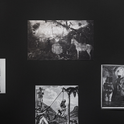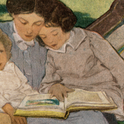The Tate has among its explicit priorities "to develop people" and "to inspire learning." But how exactly does art develop and inspire us? And what is its special advantage over science? The answer, with roots in Aristotle and developed by Freud, turns on the complex interplay between belief and desire.
In perhaps the most famous intellectual assault on art, Plato (c. 429—347 BC) proposes to banish artists from his ideal republic, branding them a danger to our learning and our souls. Art has power, he tells us, but that power is primarily negative. Far from developing our characters or inspiring us to learn, artists are entertainers who pander to rogue elements in our psychologies. They provide false images that minister to and reinforce false desires—desires that would disappear if only we became conscious of the false beliefs on which they were based. Artistic production is stultifying fantasy-fulfillment.
The notion of a "false" desire hints at a profound connection between knowledge and psychological health. My desire for what’s in the glass is "false" if, say, I falsely believe that what’s in the glass is healthy, whereas it’s really deadly poison. In a sense I don’t "truly" want to drink what’s in the glass (assuming I don’t want to die), even though I think I do. It is this idea that leads Plato to suggest that, when our desires are based on false beliefs, pandering to them is only a way of entertaining us at the expense of what we truly want.
Plato had little confidence in the ability of artists to produce works that would develop, educate, or inspire—but he did believe that genuine beauty would achieve just that. If an artist turned up who had the ability to produce not fantasy (which deals in tawdry illusions) but works of genuine imagination (which deal in beautiful images or metaphors that draw us towards truth), he would be welcome in the city. As Iris Murdoch puts it, Plato "wants to cut art off from beauty, [only] because he regards beauty as too serious a matter to be commandeered by [ordinary] art" (The Fire & the Sun: Why Plato Banished the Artists, 1977).
Aristotle, in his Poetics (350 BC), takes on the challenge to "save" artists by providing guidelines for them to produce art which ministers to "true" desires. Where Plato tends to see the artist as offering tempting fantasies, Aristotle explores how to use art to align the audience’s desires and emotions to their "true" targets. Art that meets Aristotle’s specifications will enable us to see ourselves and our environment more clearly; it will call attention to the world as it is and could be, rather than confirming us in our prejudices and perpetuating "false" desires based on those. Good art, then, will cause the audience to fear what is in fact bad; to admire what is in fact admirable; to desire what is in fact good. Aristotle suggests strategies for the artist to engage the audience’s desires or emotions in "purifying" or "clarifying" ("cathartic") ways.
If the educational and developmental value of art depends upon its capacity to reveal reality, why not just fund overtly reality-revealing disciplines like science instead? The answer is that just as a false belief can lead to the formation of a wayward desire, so a wayward desire can impair one’s ability to form a true belief. If I’ve a very strong urge to take the drug, then it might start appearing good or healthy to me—even though strictly, if I wasn’t addicted to it, I’d be able to see that it was not. If rogue desires interfere with our ability to perceive reality, then art has a distinctive pedagogical role to play.
Freud’s suggestion is that art offers symbolic substitute objects for what the individual or his society otherwise deem to be unacceptable desires. (Freud gives the example of Leonardo da Vinci’s depictions of male bodies as a symbolic substitute satisfaction for his desire for homosexual sex. It would have been better if he had used an example of something we actually think bad, rather than of something merely perceived by the artist or his society to be so. Think of your own example instead.) The great artist uses symbols to effect a redirection—or "sublimation"—of otherwise pent-up desires towards symbolically associated objects in which they can find release. An unsatisfiable desire would normally be repressed into the unconscious—from where it might wreak havoc on our ability to perceive and act. In sublimation, this potentially disruptive power is defused by being redirected—via symbolic substitution—towards something (thought of by the artist and his society as) attainable and good. (Effectively, Freud agrees with Plato that art is primarily a medium for fantasy-fulfillment, but develops Aristotle’s idea that if done properly it can have therapeutic effects.)
In an influential proposal that has affinities with Freud’s, RG Collingwood in The Principles of Art (1938) defines "art proper" as a process through which previously inarticulate agitations or sensations in the body (or brain) are brought into conscious articulation. Through art, we find symbols for our feelings. In the transition from physical agitation to conceptual clarification, rogue reality-obscuring aspects of ourselves that were previously only susceptible to brute physical or chemical treatment become susceptible to dialogue (or a "talking cure"). As Collingwood puts it in his final section: "Art is … medicine."
Plato was right to worry about the potentially stultifying effects of art. But art need not be a fantasy-satisfying diversion from reality. As Aristotle, Freud, and Collingwood suggest, it can be instead a reality-revealing educator of desire. By offering symbolic substitutes for what are otherwise rogue reality-obscuring drives or desires, it has the potential to clarify our perception and eliminate our deepest motivational conflicts. Good art effects a clarification or purification ("catharsis") of our emotions; a sublimation of desire; is "medicine" for a "corrupt consciousness."
Since Plato thinks virtue benefits its possessor, he tends automatically to consider non-virtuous desires "false" and disruptive. But whether or not we agree that true desires will always be for ethically good ends (e.g. Nietzsche disputes this), we can still acknowledge the psychological distinction between the "false" and the "true." We all sometimes find ourselves assailed by desires for things that appear good but that, in cool and calm reflection (say), we think are not really so. In these cases, we need symbolic substitutes to help re-direct and appease desire, in order for us to see reality aright.
Arts funding is regularly under threat. £50 million of public funds went into the new Tate Modern extension, but not without argument. The sciences tend to be thought of as revelatory of reality; the arts as a poor relation, providing mere entertainment (through fantasy) at best. Further to Plato’s challenge, it turns out that science needs art proper just as art proper needs science. Above all, if we want to develop people and enable learning, we need both.
What is the point of art?
Philosophers have given wildly different answers over the centuries
October 31, 2016

Plato (left) and Aristotle (right), in a fresco by Raphael











